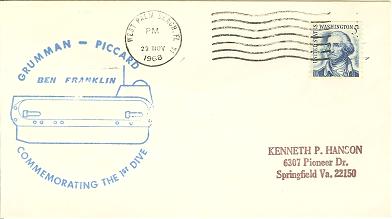|
Ben Franklin, drift mission in the Gulf Stream
 Ben Franklin (PX-15) is of Swiss genius and American `can-do` initiative. Built in Lausanne, Switzerland, by Giovanola Brothers (now Giovanola Technologies), between 1966 and 1968, PX-15 was the brainchild of famed inventor and scientist Dr. Jacques Piccard, who with his father, Auguste Piccard, pioneered the development of the bathyscaphe. PX-15 was developed with funding from NASA and Grumman Aerospace in the United States, reflecting Dr. Piccard’s ties to the US Government, Dr. Piccard made world history on January 23, 1963 with Lt. Don Walsh of the US Navy when they made a dive in Piccard`s Bathyscaphe Trieste into the Marianas Trench, which is the deepest part of the ocean – seven miles down. Since then, no one has dived deeper. Ben Franklin (PX-15) is of Swiss genius and American `can-do` initiative. Built in Lausanne, Switzerland, by Giovanola Brothers (now Giovanola Technologies), between 1966 and 1968, PX-15 was the brainchild of famed inventor and scientist Dr. Jacques Piccard, who with his father, Auguste Piccard, pioneered the development of the bathyscaphe. PX-15 was developed with funding from NASA and Grumman Aerospace in the United States, reflecting Dr. Piccard’s ties to the US Government, Dr. Piccard made world history on January 23, 1963 with Lt. Don Walsh of the US Navy when they made a dive in Piccard`s Bathyscaphe Trieste into the Marianas Trench, which is the deepest part of the ocean – seven miles down. Since then, no one has dived deeper.
The partially assembled PX-15 was shipped to Florida, completed by Grumman and named "Ben Franklin" for the American statesmen, inventor and scientist, who was the first to note and chart the presence of the Gulf Stream in the late 1700s. Ben Franklin, the submersible embarked with a seven-man crew, commanded by Dr. Piccard, on July 14, 1969, on a 30-day drift mission in the Gulf Stream, some 2,700km, with a final destination of Yarmouth, Nova Scotia, completed its unparalleled feat, no research dive has gone for a more extended dive. Ben Franklin made a few more dives after 1969, including the first deep-sea dive for Dr. Robert Ballard, the discoverer of the wreck of the Titanic.
After running aground on a reef in 1971, Ben Franklin was sold to Vancouver businessman John Horton, disassembled and shipped to Vancouver, only to languish for nearly three decades on the North Shore. In December 1999, with a sudden decision to either move or scrap the submersible, it was offered to the Museum. Private donations made it possible to retrieve Ben Franklin and all of the parts from North Vancouver, and place the sub in front of the Museum.
Fully restored it is on display at the Vancouver Maritime Museum.
Technical specifications, Ben Franklin:
Displacement (tons): 130
Weight in air (lb/kg): un known
Payload in air (kg): 5,000
Dimensions (L*W*H feet/meter): 48`9*21`6*20`0/14.85*6.55*6.10
Propulsion: four rotatable thrusters, two on each side one fwd and one aft, total power 756kWh.
Speed (sub/knots): 4.0
Range (sub n/miles@knots):10-12 hours operational time
Diving depth (feet/meter): 2,000/610
Complement: 2 crew members, 4-5researchers
Construction: Ben Franklin`s hull is fashioned from plates of 3.5-centimetre-thick steel capable of withstanding pressures at depths of up to 610m. The cylindrical hull, with an outside diameter of 3.10m, was built of welded sections of Aldur 55/68D, a high-strength steel alloy made by the Austrian firm Voest. Each end is capped with rounded hemispheres formed from six welded plates of Welmonil, a hardenable steel produced by Hoag of Germany with a nickel content of between 0.8 and 1.8%. It has 29 viewports.
 |
United States |
|
Grumman- Piccard, Ben Franklin, Commemorating the 1st dive, West Palm Beach FL, Nov' 22, 1968 |
 |
Palau |
1995 |
Ben Franklin 2,000 feet |
|